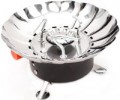Fuel consumption
The amount of fuel required for the normal operation of the burner for a certain time; usually stated in grams per hour. Different manufacturers may calculate fuel consumption differently, but most often it is indicated for normal operation, when the burner produces the power indicated in the documentation (see "Power"). Knowing the fuel consumption and the capacity of the cylinder used (see "Replaceable cylinders") or the built-in tank (see "Filling volume"), you can easily calculate the time of continuous operation of the burner.
Continuous operation time
The time that the burner is able to work without changing the cylinder or refilling the tank. Usually, the characteristics indicate the operating time at maximum power (see above); at lower power, the actual operating time may be longer than stated. However, it is best to evaluate and compare different models by directly claimed battery life.
Another important nuance is that battery life directly depends on the volume of the fuel tank — and many modern burners are designed for interchangeable cylinders produced in different volumes. Therefore, the characteristics may indicate for which cylinder model the continuous operation time is given (and for
multi -fuel models, the type of fuel should also be specified). If there are no such data, the tank capacity required for a certain time can be calculated from fuel consumption: for example, gas consumption of 180 g / h and battery life of 120 min (2 h) mean that the data are given for a cylinder of at least 360 g (400 mL) gas. With other volumes, the time of continuous operation will differ accordingly.
Boiling time for 1 L of water
Approximate time required to boil 1 liter of cold water on the burner. Of course, in fact, the boiling time may differ from the claimed one, since it is affected by the shape and material of the dishes, ambient temperature, etc.; however, this parameter quite clearly characterizes the overall efficiency of the device, it is quite possible to compare different models with each other. At the same time, it should be taken into account that when working with other volumes, the time may not change in direct proportion: for example, if 1 liter requires 300 s, then 2 liters may require not 600 s, but more, but 0.5 L — not 150 s, but less.
Weight
The total weight of the device. Usually, the specifications indicate "dry" weight — excluding fuel.
Lightness is important on long hikes where you have to carry your gear; on the other hand, ceteris paribus, less weight means either low strength and reliability, or greater cost. The lightest classic type burners and lamps (see "Type") weigh
up to 200 g, in the working position, most of the mass of such a device falls on fuel. However, there are also more massive models. For plates, in turn, lightness is not critical, and most of these models are quite heavy —
1 kg or more. In heaters, the weight can be different — from 60 – 70 g in pocket hand warmers to 1.5 kg (or even more) in powerful outdoor appliances.

